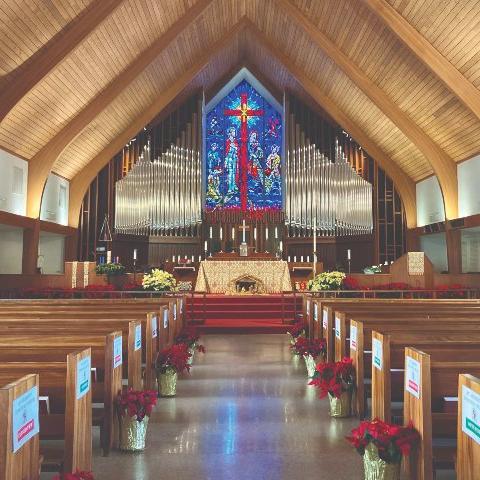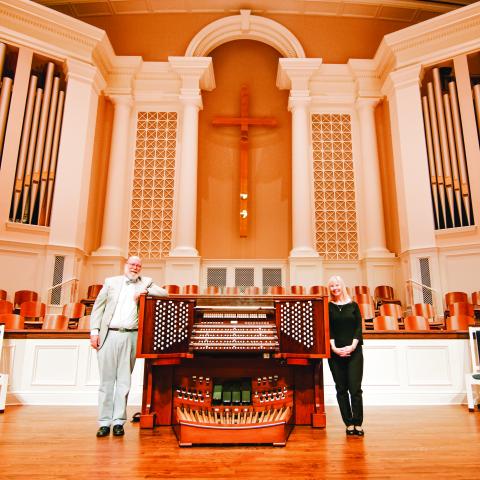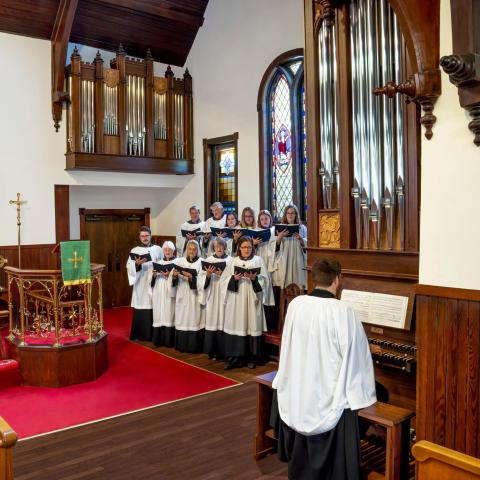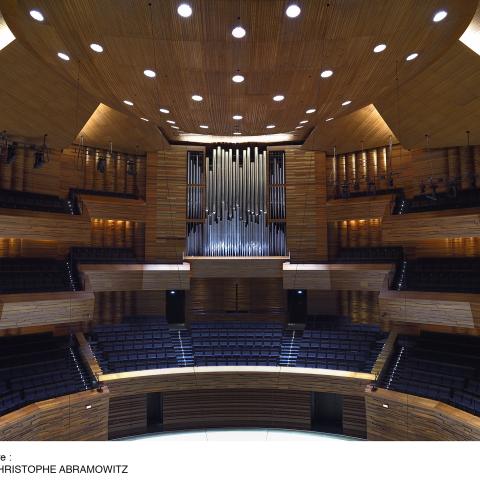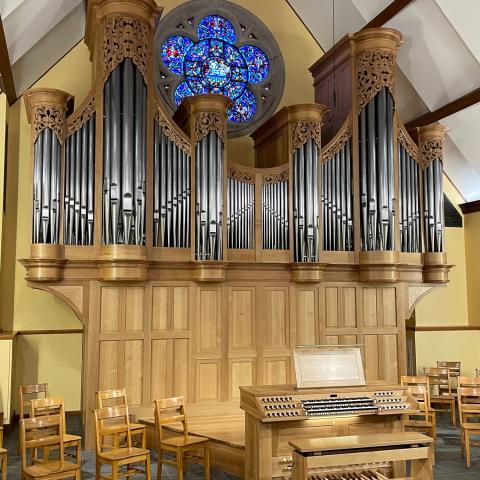Lewtak Pipe Organ Builders, Inc., Mocksville, North Carolina; Seven Oaks Presbyterian Church, Columbia, South Carolina

Music director’s perspective
The story began with our church’s celebration of its fiftieth anniversary. Like so many congregations, those years were filled with wonderful accomplishments as well as challenges and changes. As the people of Seven Oaks stepped forward in faith to envision what our next fifty years would look like, there was prayerful thought and deliberation given to the nature and forms of our worship. Worship is a defining feature of our congregation and serves as a touchstone around which we organize and prepare ourselves for lives of discipleship. The music ministry is a highly valued component of our worship and has a long tradition of excellence. As part of our visioning, a commitment was made to continue using the organ as the central instrument for accompanying, supporting, and enhancing our worship.
When the sanctuary was built, an eleven-rank W. Zimmer & Sons organ was installed. After more than thirty years of service, electronic and mechanical systems were failing. That, combined with the excessive unification of the pipework and lack of color and distinctiveness in the voicing, made it extremely difficult for the instrument to continue fully supporting our congregation’s worship.
Around the same time, Tom Lewtak, founder of Lewtak Pipe Organ Builders, was in the midst of installing a large new tracker instrument in a nearby church. He generously agreed to meet with us, look over our instrument, and make suggestions for how we might proceed. From our first meeting, it was clear that his philosophy was grounded in historical organ building practices and informed by a thorough understanding of twenty-first-century advances. More importantly, his advice revealed his attention to detail, passion for excellence, and heart for serving the needs of congregations. Then, after experiencing the exquisite craftsmanship and stellar tonal work done exhibited by some of his instruments, we were confident his firm was the ideal choice for our renovation project.
Within the constraints of our financial resources, Tom began crafting an instrument that would visually enhance our worship space and significantly expand the organ’s tonal resources. As he and the skilled craftsmen at Lewtak Pipe Organ Builders got to work, members of our congregation stepped up to renovate the pipe chamber space. Our own skilled volunteers labored for several months expanding the space, which allowed for doubling the number of ranks and significantly improved tonal egress.
As the project proceeded, there were a variety of challenges and changes that came along. The vast majority of the organ’s systems were found to be simply inadequate and needed to be replaced. As an example, the original console and keyboards could not be rebuilt, necessitating the construction of a brand new console. Still, every step of the way Tom found workable solutions that enhanced the sound, the visual beauty, and functional integrity of the instrument. In the end, what began as a renovation idea ended up as truly much more than a rebuilt instrument. We had a new organ.
Our new twenty-four-rank instrument has over 1,300 pipes. The original pipework, after proper revoicing, was used primarily to create the Great division. New pipework and chests make up an enclosed Swell division and significantly expanded the Pedal division. All pipework was voiced with extraordinary care and skill to maximize the quality and clarity of each rank and to create a satisfying ensemble sound that takes full advantage of the building’s acoustics. The new two-manual, stoptab console includes beautifully inlaid wood. It has two excellently crafted tracker-touch keyboards, all digital combination and control systems, and an adjustable speed tremulant that adapts well to music from many different periods. The organ is tuned to Neidhardt 1724 “Grosse Stadt,” a temperament that is more consistent with classical temperaments, enhancing the overall quality of the sound and adding a touch of historical authenticity to the music. The project was capped off with the installation of Tom Lewtak’s handsomely designed and crafted organ façade, which notably enriched the aesthetic quality of our worship space.
All in all, this project has reformed our church’s music and worship by creating for us an instrument having independent divisions, each splendidly colorful and powerful in ensemble. Once completed we had just a few months before the pandemic hit and worship was moved online. Now, a year later our congregation has regathered and is once again enjoying the transformation of our organ and the rich musical experience with which it enhances our worship.
We have been deeply blessed by our partnership with Tom Lewtak and Lewtak Pipe Organ Builders. Their commitment to excellence, fastidiousness, and generous spirit has made them valued partners. We now look forward to decades of music ministering and inspiring all who hear our organ to join us in giving praise to God!
—Lloyd R. Pilkington, Ph.D.
Director of Music Ministry
Technical remarks
Because right from the beginning it was obvious that this would not be a mechanical-action organ, we approached the Seven Oaks project with a dose of nervousness. Throughout our twenty years in business, we have performed many renovations of non-tracker instruments, but we had never built one thus far! In the process, we have certainly learned many things that are specific to electric-action organs—and by that we mean both the good and the bad. In general, it confirmed our long-standing conviction that, if at all possible, the choice of mechanical action is overall a better one. However, not to sound negative, we are rushing to admit that there are circumstances that make it impossible to build mechanical, and then the choice of an electric action is necessary and it can be executed in a quite satisfactory manner.
At Seven Oaks Presbyterian Church, for the new Swell division main windchest, we selected a particular chest construction, one that we felt would deliver the most satisfying musical results and be reliable for a very long time. The windchest is of a slider-and-pallet type, with pallets being fitted with balanced valves and pulled down by electromagnets. This was to avoid the effect of sudden wind rush and abrupt pipe speech caused by the magnet moving too quickly. It is not a new idea, of course, but every builder puts his/her own twist on it, and so did we, naturally. Working through the trial and error process, we arrived at a “sweet spot” ratio of the pneumatic-to-pallet area, which ended up giving us the desired effect of natural pipe speech behavior. We tried, and I think that we succeeded, to avoid having an organ that behaves too much like a machine and not enough like an instrument. The responsiveness and natural performance of the Swell chest turned out to be most pleasing both for the player and the listener.
For several other ranks, in particular in the Pedal division, we had to build many more windchests with other kinds of action. In total, because of the space limitations, there are thirteen new windchests in this organ, some as small as twelve notes and as big as 64, with a variety of action types. This entire array of components is controlled by an electronic system, integrated with the console interface.
As for the division placement, once again we had to face the limitations of available real estate. The organ chamber offered generous height, but little square footage area. With the new, greatly enlarged front opening for the façade, we decided to keep things as centered and as symmetrical as possible. The Great division was therefore placed centrally behind the front pipes, with the largest Pedal pipes occupying the space directly behind it against the back wall. The Swell, however, would not fit above it, and our solution was to split it into C and C-sharp sides and place it on two opposing ends of the organ chamber. Therefore, in reality, there are two expression boxes, with two sets of louvers operated synchronously, and with the wind supply interconnected to assure that the windchests behave like one, not two separate entities. An interesting challenge came with the tremolo, which stubbornly affected one side more than the other! It took several attempts and serious tricks to get it under control.
In all of our organs, the wind supply is purposely left a bit unstable. Not to push the needle of good taste to either extreme, we simply do not like the wind to be a “flatline,” or to be as unsteady as to become an annoyance. A middle-ground solution seems to be pleasing to most people. The organ at Seven Oaks has only one but fairly large set of bellows with double rise, inverted ribs. It guarantees generous storage capacity and steady wind pressure even at times of the highest demand. The windchests do not have schwimmer plates or “floating” regulators. Instead, there are small concussion bellows attached to individual chests, allowing for much finer regulation of wind behavior. The result is the sound that breathes with the music, naturally and discreetly.
The console layout follows a minimalistic, yet very functional design. It offers utilitarian simplicity and friendliness even at the very first contact. There is everything one might need for both service playing as well as for the most arduous literature performance. The design of the console shell is an extension of the façade motif and was made from the same species of wood. Our intention was to create a strong visual link between the two.
Lastly, I want to offer not a technical remark but something that is truly important in the overall project of this scope—the human aspect of it. At Seven Oaks Presbyterian Church, we have encountered so much kindness, understanding, respect, trust, and goodwill that we would be remiss not to give it a special mention. This was perhaps not the most high-value contract an organ building establishment would ask for, but in terms of personal satisfaction, it was a remarkable experience for our entire team. We are sincerely grateful for the friendship and support of good folks in this graceful worship community.
—Tom Lewtak, MM, MA
President
Lewtak Pipe Organ Builders, Inc.
The dedicatory recital will take place in October. The program, “Pipes of Praise,” will include music from across the centuries from Bach to Bock. Dr. Lloyd Pilkington, Director of Music Ministries, will present the recital.
GREAT (Manual I)
8′ Principal (existing)
8′ Gedackt (1–24 existing, 25–61 new)
4′ Octave (new)
4′ Gemshorn (existing)
2-2⁄3′ Nasard (1–12 new, 13–61 existing, from old Sesquialter II)
2′ Superoctave (new)
Mixture III (existing)
8′ Trompete (1–12 new, 13–61 existing)
Great to Great 4
Swell to Great 16
Swell to Great 8
Swell to Great 4
SWELL (Manual II, enclosed)
8′ Hohlflöte (new, wood)
8′ Gamba (new)
8′ Celeste TC (existing)
4′ Prestant (new)
4′ Koppelflöte (1–12 new, 13–61 existing)
2′ Flageolet (new)
1-3⁄5′ Tierce (1–12 new, 13–61 existing, from old Sesquilater II)
1-1⁄3′ Larigot (new)
8′ Oboe (new)
Tremolo
Swell to Swell 16
Swell to Swell 4
PEDAL
16′ Violon (new)
16′ Subbass (1–12 existing, 13–32 new)
8′ Octave (new)
8′ Bourdon (from Great Gedackt 8′)
4′ Choralbass (new)
16′ Fagott (1–24 existing, 25–32 new)
8′ Trumpet (1–20 shared with 16′ Fagott, 21–32 new )
Great to Pedal 8
Great to Pedal 4
Swell to Pedal 8
Swell to Pedal 4
24 stops
24 ranks
1,331 pipes (622 existing, 709 new)
Manual compass c1–c61
Pedal compass c1–g32
Electric key and stop action
Tracker-touch keyboards
Electronics by Peterson Electro-Musical Products
Tuning temperament: Neidhardt 1724 “Grosse Stadt”

